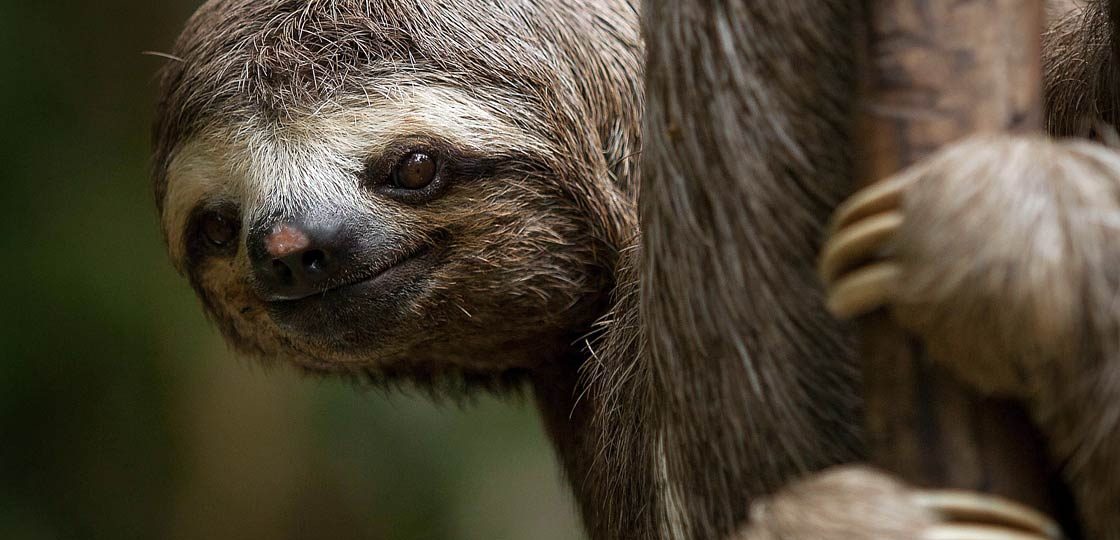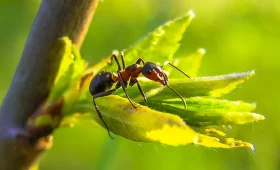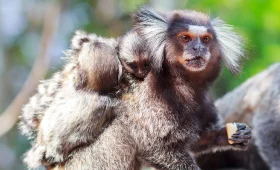memme.info – Sloths are some of the most iconic and endearing creatures in the animal kingdom, known for their relaxed and slow-moving lifestyle. Native to Central and South America, these tree-dwelling mammals are characterized by their leisurely pace, unique adaptations, and fascinating behaviors. Despite their slow movement, sloths play an important role in their ecosystems and have a variety of fascinating traits that make them stand out among other mammals.
Physical Characteristics and Unique Features
Sloths are easily recognizable due to their distinctive appearance. Their long, curved claws, which they use to hang from tree branches, are one of their most defining features. These claws can be up to 4 inches long, giving sloths an almost eerie, prehistoric look. Their fur, which is often covered in green algae, provides excellent camouflage in the treetops, helping them blend into their leafy surroundings and avoid predators.
Sloths have a small, round face with large, dark eyes that give them a perpetually “sleepy” expression. Their bodies are stocky and covered in coarse fur, and their limbs are adapted for hanging upside down. They have a low metabolic rate, which contributes to their slow movements, and a slow digestive system, taking up to a month to fully digest a single meal.
There are two main types of sloths: the two-toed sloth (Genus Choloepus) and the three-toed sloth (Genus Bradypus). The main difference between the two is the number of toes on their front limbs. Three-toed sloths have three toes on their forelimbs, while two-toed sloths have only two. Despite their names, both types of sloths have three toes on their back limbs.
Habitat and Distribution
Sloths are found primarily in the tropical rainforests of Central and South America, where they spend most of their lives in the trees. They are arboreal creatures, meaning they are adapted to live in the canopy of forests, hanging from branches with their strong claws and moving between trees in search of food.
Sloths are well-adapted to life in the trees, with their slow movements and specialized limbs that allow them to hang effortlessly from branches. Their long claws make it difficult for them to move quickly on the ground, and they are vulnerable to predators when they descend to the forest floor, which they only do infrequently, usually for a specific purpose such as defecating.
There are several species of sloths, each with slightly different habitat preferences, but all are found in rainforests, where they enjoy the lush, leafy environment. They spend the majority of their time high in the canopy, where they can find food and shelter while avoiding many ground-based predators.
Behavior and Diet
Sloths are primarily herbivores, feeding on a variety of leaves, fruits, and flowers. Their diet mainly consists of the leaves from trees such as cecropia and fig trees, which provide the necessary nutrients and moisture for survival. However, because leaves are difficult to digest and are low in calories, sloths have a very slow metabolism, and they require long periods of rest and sleep to conserve energy.
Due to their slow digestion, sloths have one of the slowest metabolisms of any mammal. They may spend up to 20 hours a day sleeping or resting to conserve energy. Their sluggish pace is a survival adaptation, as it allows them to avoid drawing attention from predators. In addition, their low metabolic rate makes them less prone to overheating, as they don’t need to expel much energy to maintain body temperature.
Sloths are incredibly slow movers, with most of their travel taking place at a pace of about 0.03 miles per hour (0.05 km/h). This slow movement is mainly due to their low-energy diet and specialized musculature, which is built for hanging rather than fast movement.
Sloths are solitary animals, preferring to live alone in the treetops. They have a simple social structure, and the only time they are typically seen interacting with one another is during the mating season. Despite their solitary nature, sloths are generally not territorial and may share a habitat with other sloths without any aggressive interactions.
Reproduction and Life Cycle
Sloths have a slow reproductive rate, much like their overall lifestyle. Female sloths typically give birth to a single offspring every two to three years after a gestation period of about six months. The young are born with their eyes open and are able to cling to their mother’s body immediately after birth. The mother will care for the infant for several months, providing protection, warmth, and nourishment.
During the first few months of life, the young sloth will remain with its mother, learning important survival skills like how to find food and navigate the trees. After this period, the young sloth begins to explore independently, although it remains close to the mother for a while longer.
Sloths can live for up to 30 years in the wild, but many face challenges due to their slow movement, which makes them vulnerable to predators like jaguars, harpy eagles, and large snakes. Despite these threats, the sloth’s ability to remain hidden in the treetops and their slow, deliberate movements help them avoid many predators.
Conservation Status and Threats
While sloths are not currently considered endangered across all species, some types of sloths are threatened due to habitat loss and other environmental challenges. Deforestation in Central and South America has been a significant factor in reducing sloth populations, as their rainforest habitats are destroyed for agriculture, logging, and development. Loss of habitat leads to fragmentation, which makes it more difficult for sloths to find food and mates.
Additionally, sloths are often vulnerable to human activity. They are sometimes killed by vehicles when they attempt to cross roads, and their slow movements can make them easy targets for hunters. Climate change also poses a long-term threat to sloths, as it could alter their habitats and disrupt the availability of food.
Conservation efforts are underway to protect sloths and their habitats. Several organizations are working to preserve the rainforests of Central and South America and to raise awareness about the importance of these animals in maintaining ecological balance. Wildlife sanctuaries and rescue centers also provide care for injured or orphaned sloths and help rehabilitate them back into the wild.
The Sloth’s Role in Ecosystems
Sloths play an important role in their ecosystems, particularly in maintaining the health of the forest canopy. By feeding on leaves, they help to prune trees and encourage new growth. Their slow movement and tree-dwelling nature also provide a habitat for other species, such as insects, fungi, and small mammals, which live in the sloth’s fur and contribute to the biodiversity of the ecosystem.
In addition, sloths contribute to seed dispersal. Some species of trees depend on sloths for the dispersal of their seeds, which are often carried in the sloths’ digestive systems and deposited in new locations when the sloths descend to the ground to defecate. This process helps to maintain the diversity of plant life in the forests where sloths live.
Conclusion
Sloths are one of the most unique and fascinating creatures in the animal kingdom, with their slow movements, specialized adaptations, and distinct appearance. While they may seem lethargic, they are perfectly suited to their environments and play an important role in maintaining the delicate balance of tropical ecosystems. However, as habitat loss and other threats continue to endanger their populations, it is crucial to continue conservation efforts to ensure that these extraordinary creatures remain a part of our planet’s biodiversity for years to come.
By learning more about sloths and the ecosystems they inhabit, we can better appreciate their role in nature and work to protect them for future generations. Sloths may be slow, but their impact on the world is significant and worth preserving.




